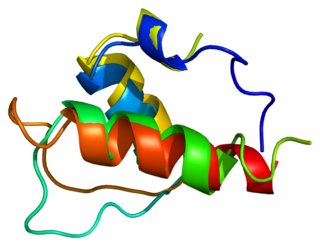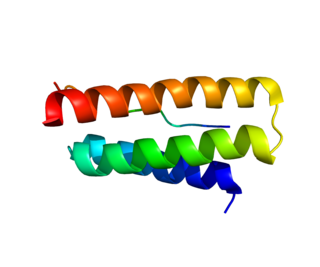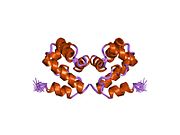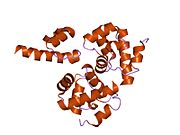
In molecular biology, SWI/SNF, is a subfamily of ATP-dependent chromatin remodeling complexes, which is found in eukaryotes. In other words, it is a group of proteins that associate to remodel the way DNA is packaged. This complex is composed of several proteins – products of the SWI and SNF genes, as well as other polypeptides. It possesses a DNA-stimulated ATPase activity that can destabilize histone-DNA interactions in reconstituted nucleosomes in an ATP-dependent manner, though the exact nature of this structural change is unknown. The SWI/SNF subfamily provides crucial nucleosome rearrangement, which is seen as ejection and/or sliding. The movement of nucleosomes provides easier access to the chromatin, allowing genes to be activated or repressed.

Ran also known as GTP-binding nuclear protein Ran is a protein that in humans is encoded by the RAN gene. Ran is a small 25 kDa protein that is involved in transport into and out of the cell nucleus during interphase and also involved in mitosis. It is a member of the Ras superfamily.

Emerin is a protein that in humans is encoded by the EMD gene, also known as the STA gene. Emerin, together with LEMD3, is a LEM domain-containing integral protein of the inner nuclear membrane in vertebrates. Emerin is highly expressed in cardiac and skeletal muscle. In cardiac muscle, emerin localizes to adherens junctions within intercalated discs where it appears to function in mechanotransduction of cellular strain and in beta-catenin signaling. Mutations in emerin cause X-linked recessive Emery–Dreifuss muscular dystrophy, cardiac conduction abnormalities and dilated cardiomyopathy.

Lamina-associated polypeptide 2 (LAP2), isoforms beta/gamma is a protein that in humans is encoded by the TMPO gene. LAP2 is an inner nuclear membrane (INM) protein.

Transcriptional repressor CTCF also known as 11-zinc finger protein or CCCTC-binding factor is a transcription factor that in humans is encoded by the CTCF gene. CTCF is involved in many cellular processes, including transcriptional regulation, insulator activity, V(D)J recombination and regulation of chromatin architecture.

Sorting nexin-1 is a protein that in humans is encoded by the SNX1 gene. The protein encoded by this gene is a sorting nexin. SNX1 is a component of the retromer complex.

CDT1 is a protein that in humans is encoded by the CDT1 gene. It is a licensing factor that functions to limit DNA from replicating more than once per cell cycle.

Chromatin assembly factor 1 subunit A is a protein that in humans is encoded by the CHAF1A gene.

SWI/SNF complex subunit SMARCC2 is a protein that in humans is encoded by the SMARCC2 gene.

Periplakin is a protein that in humans is encoded by the PPL gene.

Nuclear factor 1 C-type is a protein that in humans is encoded by the NFIC gene.

Envoplakin is a protein that in humans is encoded by the EVPL gene.

Bcl-2-associated transcription factor 1 is a Bcl-2 family protein in humans that is encoded by the BCLAF1 gene.

Charged multivesicular body protein 5 is a protein that in humans is encoded by the CHMP5 gene.

Charged multivesicular body protein 6 is a protein that in humans is encoded by the CHMP6 gene.

Charged multivesicular body protein 2a is a protein that in humans is encoded by the CHMP2A gene.
It is a reference gene.

Cell division cycle-associated 7-like protein is a protein that in humans is encoded by the CDCA7L gene.

Charged multivesicular body protein 1b is a protein that in humans is encoded by the CHMP1B gene.

Myosin-Ib is a protein that in humans is encoded by the MYO1B gene.

In molecular biology, barrier-to-autointegration factor (BAF) is a family of essential proteins that is highly conserved in metazoan evolution, and which may act as DNA-bridging proteins. BAF binds directly to double-stranded DNA, to transcription activators, and to inner nuclear membrane proteins, including lamin A filaments that anchor nuclear pore complexes in place, and nuclear LEM-domain proteins that bind to laminin filaments and chromatin. New findings suggest that BAF has structural roles in nuclear assembly and chromatin organization, represses gene expression and might interlink chromatin structure, nuclear architecture and gene regulation in metazoans.





























